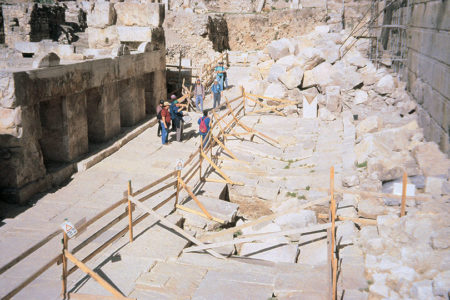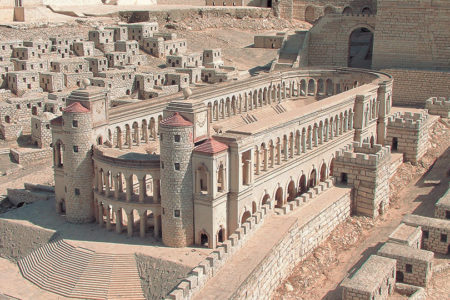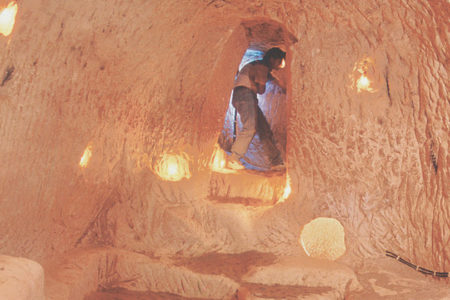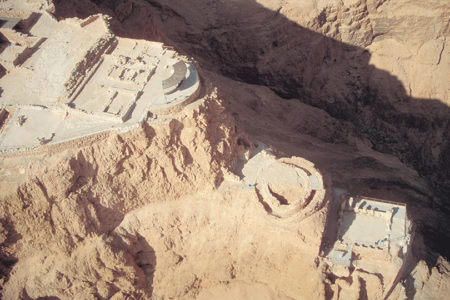Israel’s Falling Star
In the first century, the Jewish nation rejected One named Jesus as Messiah. However, few people realize that in the second century, it accepted one named Simon.
In the hundred years between the two events, the Jewish nation’s anger against its Roman masters exploded repeatedly. From A.D. 66 to 73 Rome crushed the rebellious nation and stamped out Jewish insurgence in what is called the First Revolt simply because more revolts followed.
However, the Jewish people who lived outside the land of Israel also began to rise up against the empire. Revolts then erupted from A.D. 115 to 117 in Cyrenaica (Libya), Cyprus, and Egypt, costing many lives and causing much destruction. Again Rome surpassed them. It might seem that after these two devastating conflicts, the Jewish people would finally submit to their Gentile overloads. But such was not the case. A conflict even more terrible was about to begin.
The Provocation
The First Revolt led to the destruction of the second Temple in A.D. 70. The Jewish people who survived Rome’s onslaught wondered if the Temple would be rebuilt after seventy years, as the first Temple had been after its destruction by the Babylonians (586–516 B.C.). As the years passed and the seventieth year approached (A.D. 140), Jewish hopes began to rise.
However, they soon began to fade. Initially the Jewish people had welcomed Hadrian as emperor after he succeeded the vicious Trajan, who had inflicted much destruction on them during his reign (A.D. 98–117). Hadrian had even offered to rebuild the Jewish Temple. But the Samaritans persuaded him to change his mind. Fading hope then turned to fury when Hadrian began to reconstruct Jerusalem into a pagan city. He renamed it Aelia Capitolina, after his family name (Aelia) and the sacred hill of the pagan gods in Rome (Jupiter Capitolinus).
Essential to this new Roman city would be a pagan temple on the same spot where the Jewish Temple had stood. Construction of the city began in A.D. 130. Then Jewish fury turned to rage when Hadrian prohibited circumcision. These massive affronts to Judaism fanned the embers of hatred. Preparation for war against Rome had begun. All that was needed was a spark to ignite the fire.
The Rebellion
The Jewish people in Judea patiently prepared for battle by constructing underground tunnels and collecting weapons. Hadrian witnessed the beginning of his building project in Jerusalem and then continued traveling to neighboring countries while the Jews waited for the right time to begin their war of liberation. When Hadrian returned to Rome, the pent-up anger against him burst. In A.D. 132, Jewish forces unleashed their fury against the Roman Tenth Legion, forcing it from Jerusalem. The holy city passed into Jewish hands, and the Second Jewish Revolt was under way. This victory rallied the people, propelling forces to capture Roman positions in southern Judea and eastward toward the Mediterranean Sea.
Sadly, detailed descriptions of this war are not available because no historian wrote from the inside, as did Josephus concerning the First Revolt of A.D. 70. However, the Jewish nation considered itself reborn. Jewish forces quickly defeated local Roman troops. Dates recorded on texts from the Judean desert begin with the “first year” and continue to the “fourth year” of this new Israelite kingdom. This Jewish government created new divisions of the land with local leaders and required taxes. Discipline was strict, and violation of loyalty severely punished. This united front against Rome initially proved successful. How did such national renewal transpire so suddenly and successfully? In a word, leadership.
The Leader
Twentieth-century Israeli archaeologist YigaelYadin discovered and translated many of the documents from the Dead Sea area written during the Second Jewish Revolt. In 1960 he announced to the president of Israel, “Your Excellency, I am honoured to be able to tell you that we have discovered fifteen dispatches written or dictated by the last President of ancient Israel 1800 years ago.”1
The scrolls echoed the actual name of the Jewish prince who led the revolt—Simon ben Koseva. In addition to these ancient texts, archaeologists have also discovered coins that were minted during this period. On one side is the name Shimeon ha-Nassi (“Simon, the prince”) and on the other side, the words The First Year of the Redemption of Israel. A few coins contain the image of a star over a temple. Just who was this leader who had the power to rally the Jewish people and overthrow the Romans?
Few details are known about his background, but we do know that his name was changed from Simon Bar Koseva to Simon Bar Kokhba. Numbers 24:17 prophesies, “There shall come a Star out of Jacob, and a Scepter shall rise out of Israel, and shall smite the corners of Moab, and destroy all the children of Sheth.” The Hebrew word for “star” is kokhba. Rabbi Akiba, a most highly esteemed rabbi of that generation, proclaimed of Simon Bar Koseva, “This is the King Messiah.” 2 In a play on words, Rabbi Akiba changed Kosevato Kokhba, thus calling Simon the Messianic “Star” of the famous prophecy—Simon Bar Kokhba. (Bar is Aramaic for “son” and ben, Hebrew for “son.”)
However, not everyone agreed with Rabbi Akiba. Rabbi Yohanan is said to have told him, “Akiba, grass will grow out of your cheekbones and the Son of David will still not have come.”
A significant group also did not submit to Simon’s rule: the Jewish believers in Jesus. Church fathers Justin and Eusebius recorded that Simon persecuted Christians in Judea for their disloyalty. “It was only Christians whom Bar Chocheba, the leader of the Jewish rebellion of the Jews, commanded to be punished severely, if they did not deny Jesus as the Messiah and blaspheme Him.”3 Jewish Christians suffered for their obedience to Messiah Jesus during the reign of pseudomessiah Simon.
Most Jewish people, however, resolutely followed their new warrior-king. Bar Kokhba inspired his followers by setting an example of both military and religious zeal. Ancient texts from the Dead Sea area reveal his zealous desire to keep the Sabbath and strictly observe Jewish holidays. They also indicate his stern leadership style. For example, he assumed ownership of Roman lands and leased them to fellow Jews to farm. He replaced the Roman emperor’s authority with his own absolute authority. He chose leaders who could uproot cedar trees or endure having a finger chopped off. Though little else is known of him, one thing is certain: Under Bar Kokhba’s leadership the new kingdom of Israel successfully withstood the Roman Empire for three years.
The Disappointment
After losing to Bar Kokhba and his troops for three years, the local Roman garrisons grew frustrated. They could not win against the fierce Jewish fighters who hid in caves and avoided open warfare. So Hadrian summoned from Britain one of his finest generals, Julius Severus, to lead the war.
Under Severus, Rome’s tactics changed from traditional combat to slow, pinpointed destruction of the Jewish people. This was no small contest. Legions arrived from Egypt, Syria, and Britain to bolster the Romans in Judea. The reinforced troops recaptured Jerusalem. Bar Kokhba’s forces had valiantly held their holy city for three years, as the Dead Sea texts indicate with the date, “the third year of the freedom of Jerusalem.” Jewish rebels withdrew to small towns throughout Judea.
As the Roman armies continued to flush them out of caves and starve them out of their enclaves, Bar Kokhba and his beleaguered forces gathered in the town of Bethar, about six miles southwest of Jerusalem. However, the Romans encircled the city and starved them. Final defeat came in a battle on the ninth day of the month of Av (in Hebrew, Tisha b’ Av). According to rabbinic tradition, the first and second Temples were also destroyed on the same date. And so, after three and a half years, the short-lived Jewish state came to an end in A.D. 135.
Simon Bar Kokhba died in that final battle. He was given another name in Jewish texts: Simon Bar Koziba. Although it may sound similar to his actual name, Bar Koseva, Bar Koziba is a Hebrew pun meaning “son of the lie.” Whether it was invented during his lifetime by his opponents or showed up after the war, the message is clear: Simon was not the Messiah but rather an imposter. And Jewish tradition ascribes the defeat to his sinful pride.
Roman historian Dio Cassius summarized the results:
Fifty of their [the Jewish people’s] most important outposts and nine hundred and eighty-five of their most famous villages were razed to the ground. Five hundred and eighty thousand men were slain in the various raids and battles, and the number of those that perished by famine, disease and fire was past finding out. Thus nearly the whole of Judaea was made desolate.4
The Jews who survived were sold as slaves. Their selling price equaled that of a horse.
Hadrian won, and his general received appropriate honors. But the cost to the Roman Empire was high. When the emperor wrote to the Senate describing his victory, he omitted the usual greeting, “I and my troops are well.” Jerusalem now became what Hadrian had planned earlier—a pagan city. To insult the Jewish people, the Romans constructed a temple to Jupiter (Zeus) on the site of the Jewish Temple and carved a pig’s image into one of the city gates. And to insult the Christians, Hadrian erected a shrine to Aphrodite (Astarte) where Jesus had been buried.
The rabbis saw Hadrian as another Antiochus Epiphanes, the Greek oppressor who ruled in the 160s B.C. For Christians, he is a reminder of the coming Antichrist, who will persecute the Jewish people in the future Tribulation.
The Results
The war devastated the Jewish people. They were forbidden access to Jerusalem under pain of death. The Roman province of Judea was renamed Palestine, after the Philistine enemies of the Israelites. The center of Jewish spiritual life remained in the land but moved north to Galilee. With the Temple and the sacrificial system gone, the rabbis began to focus on the study of Torah. Consequently, Judaism evolved into a religion dependent on good works, rather than on blood sacrifice as prescribed in the Hebrew Scriptures. All nationalistic aspirations became but distant hopes until the 1800s. Messianic speculations dimmed and would not resurface until another imposter, Shabbetai Zvi, appeared in the 1600s.
Jewish-Christian relations suffered after the Second Revolt. Jewish believers in Jesus would not follow Simon Bar Kokhba. The war accelerated the parting of the ways by revealing the true loyalty of Jewish believers in Jesus, the true Messiah and real Bar Kokhba—“the bright and morning star” (Rev. 22:16).
ENDNOTES
- YigaelYadin, Bar-Kokhba (New York: Random House, 1971), 15.
- Palestinian Talmud, Taanit 84, 68d.
- Eusebius, The Ecclesiastical History, 4.8.4.
- Dio Cassius, Roman History, 14.







